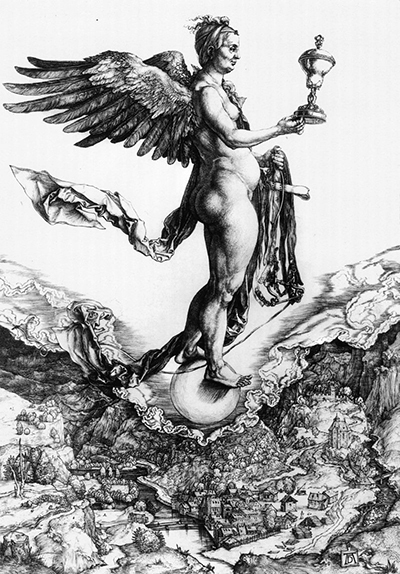Nemesis, created by Albrecht Dürer in 1502, is an engraving that depicts a winged goddess who stands on a globe that hovers above a town in the mountains. Chiusa, situated in South Tyrol and also known as Klausen, is believed to be the town that appears in the engraving and it is known that the German artist passed through the commune on his way to Venice.
The figure, while identified as the Greek deity Nemesis, possesses several characteristics of the Roman goddess Fortuna and it is possible that Dürer considers these figures to be different manifestations of the same archetypal being. The figure, nude and standing in profile, holds a goblet in one hand and a bridle in the other while a lengthy piece of fabric floats behind her. It is possible that the goblet represents Fortuna’s cornucopia, or horn of plenty, while the bridle represents the restraint that Nemesis places on those who exhibit arrogance before the gods. It could be said that both Fortuna and Nemesis, like two sides of the same coin, are bestowing justice upon humanity in the form of punishment or reward. Hubris, or excessive conceit that provokes the wrath of the gods, leads to retribution from Nemesis while honourable deeds may result in Fortuna’s blessings.
Dürer, who created the original artwork, may have employed a craftsman to engrave the image into the copper plate with a burin while the ink-on-paper prints would have been created by professional printmakers. There is little doubt that the German artist, who had trained as a goldsmith and served as an artist’s apprentice, was a gifted engraver in his own right but it would have been usual for him to delegate such tasks to others. It was easier to engrave fine details into brass, bronze or copper plate than it was to carve such levels of detail into wood and this image displays a level of intricacy that could only have been created by the fine point of a burin.
Seven original prints of the engraving, measuring 33 by 23 centimetres and also known as the The Great Fortune, are known to survive. The ability to duplicate engraved images gave artists of the Renaissance period the opportunity to earn money by increments, via the sale of multiple copies of their works, rather than having to rely on the large purses provided by patrons. Destruction of the engraving, after a certain amount of prints of it had been made, enabled the images to retain their value.




